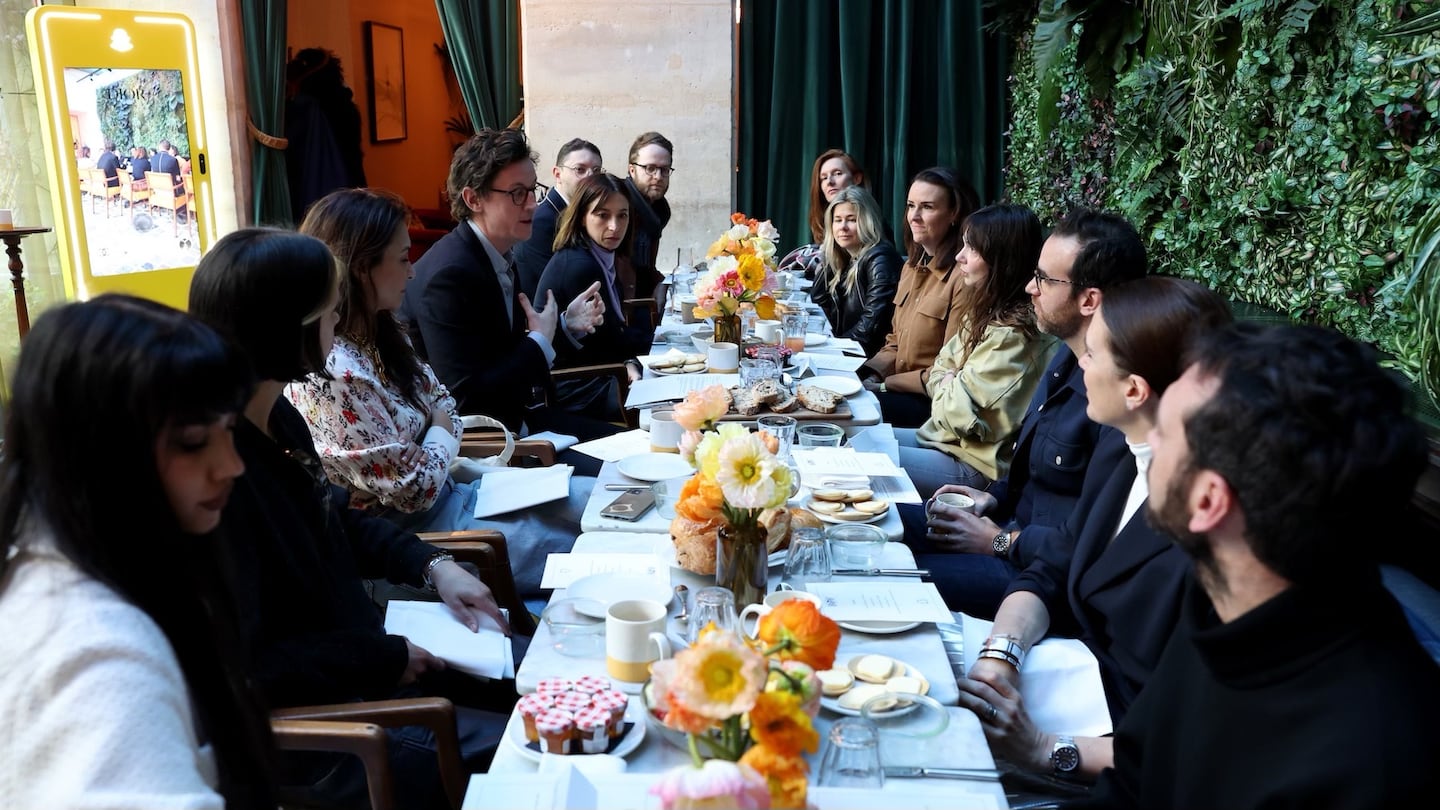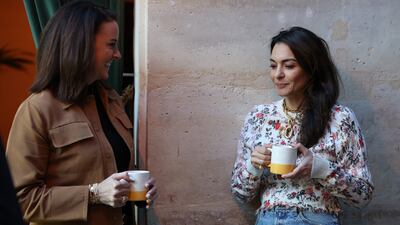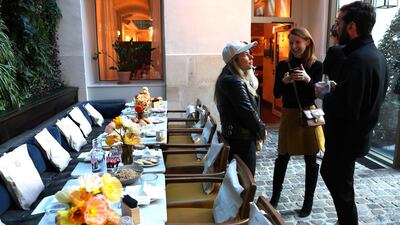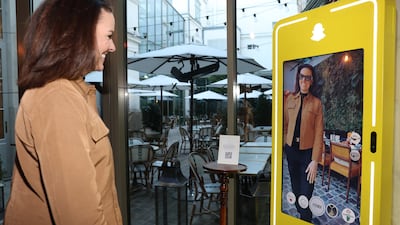
The Business of Fashion
Agenda-setting intelligence, analysis and advice for the global fashion community.

Agenda-setting intelligence, analysis and advice for the global fashion community.

Already accounting for 25 percent of the global population and over half of the global workforce — Gen-Z is the largest and the most online generation ever. In the US alone, Gen-Z consumers have an estimated purchasing power of $360 billion, according to BoF Insights. By 2025, according to research conducted by Deloitte, 75 percent of the global population and almost all smartphone users — and therefore almost all of Gen Z — will be frequent users of augmented reality.
As a foundational technology, creating access to new digital product lines, 3D fit solutions and immersive experiences, AR has the opportunity to transform customer interaction and experience. Indeed, even now, AR technology is fast becoming a ubiquitous feature of daily life, with social media acting as a frictionless forum for users to interact with AR seamlessly through filters and lenses, as well as physical and digital activations continuing to merge.
However, concurrent to this evolution is a challenging global financial outlook. The McKinsey Pulse Survey found that 37 percent of consumers plan to delay discretionary expenditure, shop from lower priced retailers or seek savvier retail experiences in 2023. Consumers have begun to reconcile fiscal caution with spending impulses by being highly selective about which brands and experiences to engage with.
As a result, retailers need to be laser focused on the path to purchase, balancing innovations that can surprise and delight customers by connecting them to new forms of creativity, while investing in the channels and functionality that drive the bottom line.
In addition to impacting acquisition and conversion rates, AR and fit guidance technology can positively impact returns rates. Returns represent a loss of $550 billion worldwide for retailers and have a huge environmental cost. According to studies carried out by Snap, 66 percent of e-tailers claim they’ve had fewer returns after implementing this technology.
Responding to this opportunity, in March, Snap launched Ares, a SaaS service providing Snap’s AR technology with the technology it gained from its acquisitions of Vertebrae, Fit Analytics, and Forma. Ares’ first solution, dubbed the Shopping Suite, includes 3D Viewer, AR Try-On, and Fit Finder, all of which can be embedded into retailers’ own apps and websites.
0 of 10
To discuss how AR can innovate the shopping experience most effectively today, Snap’s head of AR enterprise services Jill Popelka and global head of luxury Geoffrey Perez, alongside BoF’s Robin Mellery-Pratt, hosted a roundtable discussion at The Hoxton in Paris, welcoming executives from Louis Vuitton, Jacquemus, Acne Studios, Paco Rabanne, Christian Louboutin, Longchamp, Maje and Dentsu. Now, BoF shares key insights from the conversation, conducted under the Chatham House Rule.
“We did mirrors with Nike in Williamsburg and what they did was a gamification of the whole AR experience. You were able to play basketball in the mirror and then at the end, you could get a QR code to get a 10 percent discount. You could have something to be part of the community, to engage, to share on social media.
“When you have a mirror in your store, you don’t need to have Snap, you just scan the QR code, upload the photo on your phone and then you get to share it. There is no link between the technology that we have here and if you’re a Snap user or not,” said a Snap representative.
“If you look at what Dior did in Mumbai — they added that layer of augmented reality to transform the Gateway of India with Snap. Of course, we’ve already proven to Dior that our technologies were super efficient — they have dozens of lenses that they’ve created with us in the past two years. They’ve seen amazing results in terms of engagement and conversions,” they continued.
In-store, you need to have that kind of enhanced experience. It cannot only be reserved for online. It’s about creating a parallel world and then having the ability to share something very fun.
However, another executive believes physical interaction is the core driver in increasing dwell time. “In-store activation has the main impact on dwell time. From what I’ve seen throughout my last 15 years in retail, the most powerful activations are the ones that are actually living.
“When we opened, we had [a branded food-focused physical activation] and people were more keen on getting popcorn and photos rather than the virtual try-on of product. People are coming in-store because they want to live real life, otherwise they buy online. You want to feel and touch things. It’s why I believe physical activations will always heighten the experience.”
“[Consumers] are seeking real experiences they can share with their community. We have seen that gaming can be a powerful avenue for this. So, in-store, you need to have that kind of enhanced experience. It cannot only be reserved for online. It’s about creating a parallel world and then having the ability to share something very fun,” shared another guest.
“That’s why you have to find the right angle and use of AR. If you want to use it for fit technology in-store, there’s little point because the consumer can try things on physically. However, if you are creating additional experiences, that’s where you’re adding value,” another attendee added.
“We believe that the minute you buy a product, you enter the brand and become part of the family. That’s why gamifying the experience of users is something we’re still investigating, in order to build that relationship. The sneaker business, for example, is something that brings back clients. We also know that linking to brand heritage plays a key role to building a long-lasting relationship. Virtual reality can really help in those instances — activating your clients in a different way,” one guest mentioned.

“We were working on a gamification project, but we didn’t want to launch a game just for the sake of it. That is not how we operate as a company. We require more time and are still working on it. Our focus for this is not really centred around our products, but more around the DNA of our brand and universe,” another guest shared.
“Virtual try-on works really well in beauty. Yet, for shoes, it’s more difficult. While it has clear success in the sneaker category, we also produce heels. For that type of shoe, it’s still quite challenging. Although we work with Snap and with all the best tech in the world, the technology cannot handle the elevation of the heel, let alone open toes etc. So, we haven’t implemented AR as much as we would have liked,” an attendee highlighted.
Adding onto this, another attendee mentioned: “We’ve found that the technology is not always mature. We have trialled it for many categories — sunglasses, earrings and sneakers. Every time, we’ve had to use different partners because there’s not a single one that’s able to mesh the technology for all those parts of the body. For makeup, there are really good companies but they’re not good in shoes, and vice versa, so it’s a challenge.”
“[In my previous role,] we launched with sneakers [... and] 1.5 million people have tried on our sneakers in augmented reality on Snap. Our success came from the balance of finding the perfect way to propose it to the customer, while remaining super focused on the DNA and feel of the brand,” said another guest.

“We organised a digital showroom during our press day and invited VIPs. That experience helped strengthen relationships, as clients were able to make a wish list then and there from the digitised product. It also enabled our clients to be connected with the brand and create a much more emotional experience,” an attendee added.
A Snap representative stated: “You can now use augmented reality with a forward facing camera, your phone, laptop — just about anything. The more organisations get their teams comfortable with creating 3D assets and using them in that forward facing view, the more they’ll be ready for things like smart glasses when they come along.”
“The issue is who is deciding to spend the money. If it’s the CTO, they know that time spent engaging is super valuable. If it’s the CFO or general manager, they want a return on investment very quickly, because [their] way of thinking is from a business perspective rather than from a technology or community standpoint.
“When you know retail and understand that building a relationship comes through spending time in the store, you then know how to translate it onto your website. [Through this,] you are able to sell and offer the user your brand experience, so it should be considered as part of the calculation,” one attendee expressed.

“It’s important to consider what the metrics for success are. We have tried products such as eyewear, scarves and bags to stage augmented reality and virtual designs in-store. But, across different platforms, it can be difficult to connect the dots. However, considering engagement and number of shares can be really useful,” another guest added. “For bosses, it’s difficult to switch from quantitative to qualitative KPIs in retail. It’s a key consideration, because we are ultimately selling an experience.”
In 2022, returns represent a loss for retailers of $550 billion. As much as between a quarter and a third of garments will never be sold and will be wasted. The industry remains steadfastly linear — billions of pieces of clothing are simply discarded when unsold or at the end of their useful lives, ending up in landfill or incinerators.
A Snap representative stated: “What we have found is that when you combine augmented reality and artificial intelligence, there’s actually a superpower to reduce returns and increase conversions. It’s combining those two technologies that can help create shopper confidence. We’ve taken fit and sizing technology, which we can do without a size chart, because the machine learning algorithms can actually take buyer data and solve it. What we believe is important is that [brands] start those processes internally and think outside of their perceived boundaries of technology.”
This is a sponsored feature paid for by Snap as part of a BoF partnership.
The app, owned by TikTok parent company ByteDance, has been promising to help emerging US labels get started selling in China at the same time that TikTok stares down a ban by the US for its ties to China.
Zero10 offers digital solutions through AR mirrors, leveraged in-store and in window displays, to brands like Tommy Hilfiger and Coach. Co-founder and CEO George Yashin discusses the latest advancements in AR and how fashion companies can leverage the technology to boost consumer experiences via retail touchpoints and brand experiences.
Four years ago, when the Trump administration threatened to ban TikTok in the US, its Chinese parent company ByteDance Ltd. worked out a preliminary deal to sell the short video app’s business. Not this time.
Brands are using them for design tasks, in their marketing, on their e-commerce sites and in augmented-reality experiences such as virtual try-on, with more applications still emerging.